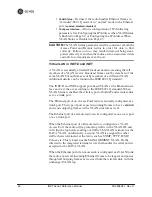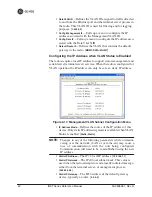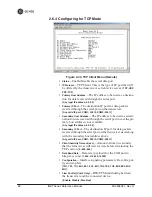
05-2806A01, Rev. H
iNET Series Reference Manual
53
TIP:
If a packet is being transmitted and the dwell time
expires, the packet will be completed before hopping to the next
frequency.
•
Beacon Period
—Amount of time between Beacon transmissions
(in msec).
Available Intervals:
Normal
(104 ms),
Fast
(52 ms),
Faster
(26
ms),
Slow
(508 ms),
Moderate
(208 ms). These values provide rel-
atively quick association times where Fast is very fast (
≈
5 sec)
and the other end, the largest recommended value, the 508 ms
period is slow (
≈
60 sec). [
Normal, Fast, Faster, Slow, Moderate; Nor-
mal
]
TIP:
Increasing the Beacon Period will provide a
small
improvement
in network data throughput. Shortening it
decreases the time needed for Remotes to associate with
the AP. A short beacon period is usually only a benefit
when there are mobile Remotes in the network.
•
Hop Pattern Seed
—A user-selectable value to be added to the hop
pattern formula. This is done in the unlikely event that identical
hop patterns are used with two collocated or nearby networks.
Changing the seed value will minimize the potential for RF-sig-
nal collisions in these situations. (This
fi
eld is only changeable
on an Access Point. Remotes read the AP’s value upon associa-
tion.) [
0 to 255; 1
]
•
Mobility Con
fi
guration
—This selection brings up a submenu
where parameters related to mobile operation may be set. For
details, See
“
Mobility Configuration Menu” on Page 58
.
•
Fragment Threshold
—Before transmitting over the air, if a packet
exceeds this number of bytes, the transceiver sends the packet in
multiple fragments that are reassembled before being delivered
over the Ethernet interface at the receiving end. Only even num-
bers are acceptable entries for this parameter. Over-the-air data
fragmentation is not supported on AP units.
(See
“
PERFORMANCE NOTES” on Page 144 for additional
information.) [
256–1600 bytes; 1600
]
TIP:
In an interference-free environment this value should be
large to maximize throughput. If interference exists then
the value should be set to smaller values. The smaller the
packet the less chance of it being interfered with at the cost
of slightly reduced throughput.
•
RTS Threshold
—Number of bytes for the over-the-air RTS/CTS
handshake boundary. (See
“
PERFORMANCE NOTES” on
Page 144.) [
0 to 1600 bytes; 500
]
NOTE:
While the transceiver accepts RTS Threshold settings below
100, the lowest functioning value is 100.
Содержание MDS iNET-II 900
Страница 12: ...2 iNET Series Reference Manual 05 2806A01 Rev H...
Страница 32: ...22 iNET Series Reference Manual 05 2806A01 Rev H...
Страница 122: ...112 iNET Series Reference Manual 05 2806A01 Rev H...
Страница 124: ...114 iNET Series Reference Manual 05 2806A01 Rev H...
Страница 136: ...126 iNET Series Reference Manual 05 2806A01 Rev H...
Страница 138: ...128 iNET Series Reference Manual 05 2806A01 Rev H...
Страница 162: ...152 iNET Series Reference Manual 05 2806A01 Rev H...
Страница 164: ...154 iNET Series Reference Manual 05 2806A01 Rev H...
Страница 174: ...164 iNET Series Reference Manual 05 2806A01 Rev H...
Страница 182: ...172 iNET Series Reference Manual 05 2806A01 Rev H...
Страница 190: ...GE MDS LLC Rochester NY 14620 General Business 1 585 242 9600 FAX 1 585 242 9620 Web www GEmds com 175 Science Parkway...
















































